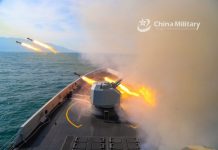As tensions mount on India-China border up in the Himalayas and in the South China Sea with Japan, Taiwan and most of ASEAN nations, the US could equip some of China’s foes in Asia with the state-of-art, stealth, fifth-generation F-35 jets.
India, Russia Could Sign Whopping $15 Billion Inter-Governmental Defence Agreements
With an ambitious goal to build a light aircraft carrier akin to the controversial USS America which houses about two dozen F-35B fighter jets, South Korea has revealed its plans about building such aviation-centric platforms.

The LPX-II program, which was previously referred to as LPH-II, was unveiled in a recent defence spending plan for 2021 to 2025 released on Monday. A new detailed graphic of the ship’s design was also released by the South Korean Ministry of Defense, also linking to the procurement of the F-35B jets from the US.
Russian Fifth-Generation Su-57 Jets Ready To Challenge US’ F-35s, F-22s By End Of 2020
It is anticipated that South Korea will purchase F-35B jets, which have short takeoff and vertical landing capability, compatible with a small aircraft carrier. F-35Bs are the only short take-off and vertical landing fighter jets in production in the world. The ROKAF is expected to operate 60 F-35As and 20 F-35Bs by 2030.
Taiwan’s New ‘Training Jets’ Are Capable Bombers That Can Strike Deep Into China
With the possibility of being surrounded by three countries armed with the new 5th-generation Joint Strike Fighter jets, China has always opposed the sale of these aircraft to its neighbours. Along with South Korea, Japan and Singapore are also working actively for the procurement of F-35s from the United States.
India, Russia Could Sign Whopping $15 Billion Inter-Governmental Defence Agreements
Calling its claims in the South China Sea “completely illegal”, Donald Trump now seems to be assembling a coalition against China. The recent developments in the region indicate a strong will of the smaller nations to fight the threat posed by the Chinese forces.
With a spike in tensions, the U.S. Navy moved two supercarriers USS Nimitz and USS Ronald Reagan to the disputed sea for the first time after 6 years as a show of force. The two supercarriers then went on to conduct exercises with India, Japan and Australia called “The QUAD”.
Lockheed Bags Contract To Equip Indian MH-60R Helicopters With Low-Frequency Sonars
In response to the exercises, China has repeatedly engaged in a ‘war of words’ via its state-owned news agency Global Times, threatening the US navy ships with its DF-26 “Carrier-killer” missiles and accusing the United States of escalations in the area.
Recently, Taiwan, too deployed its F-16s on patrols against alleged Chinese military exercise against its Pratas Islands, as reported by EurAsian Times earlier. This was followed by a deployment of Marines and consolidation of defences.
Turkey’s Latest, Cutting-Edge Armed Drone ‘Akinci’ Hits Another Big Milestone
Japan is also reported to be strengthening its military preparedness against China. Recent reports of territorial violations by the PLA-N in the Japanese Senkaku/Diaoyu islands for more than three months has triggered the changing of the “self-defence-only” policy of the island nation. As a countermeasure, Japan announced that it would scramble its fighter jets against any sortie carried out from the Chinese Fujian airbase.
In December 2018, Japan declared it was refitting its Izumo-class helicopter destroyers to carry the F-35Bs — a momentous transit as the country hasn’t put aircraft carriers to sea since World War II. The US also bases an amphibious assault ship, as the US Navy calls its small carriers, with F-35Bs in Japan.
U.S. Awards Whopping $62 Billion Contract To Lockheed Martin For Arming Taiwan Against China?
In procuring the F-35Bs, South Korea joins the US, Japan and the UK as the only nations with the fifth-generation stealth jets, which Lockheed-Martin says “redefines the multi-role fighter.”
F-35Bs are fifth-generation jets, capable of flying at Mach 1.6 — more than one-and-a-half times the speed of sound — and landing vertically. The planes can carry two air-to-air missiles and two 1,000-pound guided bombs in their internal weapons bays.




